

THIS chapter is the story of how a poor but honest chess program eventually played in the World Championship.
In 1954 Professor Nils Barricelli was visiting Princeton University. The University was then a leader in the new field of computing mainly due to the presence of von Neumann and his development of the (amongst others) MANIAC machines.
In a discussion with Reuben Fine, the well-known Grandmaster and psychologist, Barricelli said that he intended to program a machine in order to beat Fine in chess. Professor Fine replied that he was sure the machine would play a poor game. Whereupon we asked von Neumann of his opinion. He agreed with Professor Fine on the grounds that the machine was not even capable of translating from a foreign language into a decent English. I think that was a poor argument, but that was anyhow his opinion."
Von Neumann could speak five languages fluently. Even more important - the remark is extremely relevant - chess has a language, a game is a conversation of a kind.
In 1962 Barricelli arrived at Manchester University in order to use the Atlas computer, a machine with many new features and probably, at the time, the most powerful computer in the world. His intention was to write a chess program which would be used to study certain theories of evolution. I was at Manchester at the time having just finished a year of computer research. Having also just got married I had turned my attention to the mundane problems of earning a living and was told that a Dr. Barry Chelly was looking for someone to write a chess program for Atlas. My first job ever was to help write a list legal moves generator for any chess position on a machine which was barely operational.
Cooper and Kozdrowicki have remarked that chess will persist, for the problem is so exciting that once a programmer gets involved there is virtually no way he can be stopped. Personally I do not agree but I do remember that working with Barricelli was an interesting experience which definitely sold me on a career in computing although Manchester was an exciting place for computer users in almost any subject at the time.
The legal-move generator had to be as fast as possible because it would be used by symbio-organisms - numerical patterns in the machine which could reproduce and mutate - to test evolutionary theories. In order to survive and grow these organisms had to learn how to play chess; this was their test in their battle for survival.
In early tests the organisms actually invaded the private parts of the machine and halted it.
At the time we did consider making the program play a game against a human (though I would stress that this was not the aim of the project). Without reference to any literature we wrote a Shannon-Turing look ahead (it is a very obvious model) and an evaluation function based purely on mobility. We spent a whole week on this and the results were discouraging - we could beat it easily. Nevertheless it was a useful program for testing the, then, very new Atlas and on one occasion it ran silent and deep for 20 minutes before making its opening move, P-K4.
At the time this was probably the first fully legal chess program to run in England (possibly the world) but Barricelli's grant ran out and, seeing no pecuniary future in the subject, I went off to earn a living doing something useful. I was, however, left with the naive impression that a chess program could be built in three separate parts, namely: (a) list legal moves; (b) look ahead; (c) an evaluation function.
For the next 5 years I worked on systems at the Atlas Computer Laboratory, mainly developing and extending an Algol Compiler. In 1967 it at last became possible to go on-line to a program in the machine and I resurrected Barricelli's old program, cleaned it up, rewrote it in ALGOL and put it on the machine.
This version was mainly a demonstration program for the new on-line console. Much of the effort went into producing an agreeable input/output system - for example, the program would ask what colour the opponent wanted, type 'EH? if he entered an illegal move, output its own move in descriptive form and, if required, print the current position of the board.
Its strategy was simple, it looked only 3 plies ahead and would accept almost any captures in that depth with weighting on swaps of the more powerful pieces, i.e. it would always swap a queen for a queen. If no captures were present it prepared to castle or mini-maximised its mobility. A slight modification prevented it from moving its queen in the first 5 moves.
This program, although written in ALGOL, used the alpha-beta principle and could respond almost immediately to the moves of the opponent - and it was fairly pathetic. One of its first games was against Lord Halsbury, a weak player but one who knew how to get at a king side castled position - his Black queen went to KN3 and then his bishop went to KR6 - it was al1 over in 20 moves.
Nevertheless I felt that this strategy of capturing as often as possible would fare quite wel1 against other chess programs. Even in 1968 it was quite obvious that chess programs could win massive material advantages and still not know what to do - MACHACK had clearly shown this failing on occasion.
The only other chess program in England in 1968 was one written by John Scott, then a 17-year-old schoolboy. His program actually played MACHACK at the Edinburgh IFIPS (International Federation of Information Processing) and just lost after a long struggle (see also Chapter 8). John and I were present at a talk a few days later by Jack Good who analysed this game; in fact, we both remember that some of the reasons given for John's program choosing a move were, in Our opinion, over-sophisticated.
John and I arranged to play our programs against each other. I was interested to see how the simple strategy of attrition at 3 plies would fare against a more sophisticated program. Only two games were possible because neither program could learn or randomise equal possibilities. Here is one of them
SCOTT ATLAS
1 P - Q4 N - QB3 attacks pawn
2 P - K4 P - K3 mobility
3 P - Q5 B - N5 + horizon effect
4 P - QB3 B - B4 mobility
5 P - QN4 N x P best capture
6 P x N Q - B3 horizon effect
7 P x B Q x R
8 B - Q3 Q x P
9 N - KB3 P x P inevitable
10 P x P Q x P
11 N - B3 Q x P
12 B - Q2 N - B3 prepare 0-0
It is a silly game with ATLAS clearly suffering from the horizon effect at moves 3 and 6. Despite this SCOTT does not take full advantage, it failed to develop any pieces until move 8 and consequently got itself into trouble.
So at the end of 1968 I was fairly sure that chess programs might fool some people some of the time but they really could not know, in any real sense, what they were doing, mainly because they were too short sighted. Almost any chess player, provided he kept his nerve and never resigned, could - by following a simple plan of swapping off - almost guarantee that even MACHACK would not beat him.
So once again I went off to do something useful - to Paris this time where I finally learnt that any talent for writing programs has very little to do with the brave, new world of computers.
In 1972 I was back in England again and met John Scott, who was doing a PhD, and his tutor Dr. Alan Bond. Naturally we talked about chess programs and the recent happenings in the American ACM tournaments. As we talked it became fairly obvious that in the intervening 4 years a number of new ideas had appeared on the scene. One idea was called refutation, a technique which (like alpha-beta) could vastly speed up the tree searching without any loss of information (see Chapter 9 - Machine Technique).
Even more mysterious was a paper Multi Dimensional Structure in the Game of Chess by Ron Atkin, a maths lecturer at Essex University. Up to this point all chess programs had evaluation functions which were decidedly ad hoc, the programmers had a feeling in their water that certain features, material, mobility, control of the centre, king safety, pawn structure, etc., were the most important and accordingly stuck them in the program with very little idea of their precise effect. Now here was a mathematician who, with lots of squiggly things, appeared to have a precise mathematical evaluation function. Unfortunately neither John nor I could understand the paper - so why not get Atkin to talk about it. There were a few other new ideas I did not understand - a new, knowledge approach to solving end games and some psychological theories about how chess players think-so why not have a conference? If nothing else I might get some idea of what was going on.
The first Computer Chess Conference took place at the Atlas Computer Laboratory in May 1973. Apart from inviting the speakers it was also obvious that the conference would have to demonstrate a chess program in some form and it is at this point in time that MASTER really got started.
I had left my old program purely as an on-line demonstration.
Getting a program on line is, even now, quite difficult but this fact was usually not appreciated - after all chess programs only play chess and are misjudged accordingly.
Its evaluation was based simply on capturing plus mobility and, although it worked to a certain extent, had two noticeable weaknesses: (1) no value was given to an undeveloped piece, such as a rook or bishop, and (2) the queen tended to come out too soon. These faults, combined with the horizon effect caused by a too shallow search, made the program very weak; in fact it never beat anybody. One of the programmers at Atlas, Peter Kent, had taken over the program and modified it to maximise the number of squares controlled. This, combined with a few other improvements, had produced a much stronger program - as Peter later wrote
The program captured if you gave it the chance, moved a piece if threatened, but still generally displayed no imagination. The computer operators used to play the program at night and write sarcastic comments on the output after winning in 15 or so moves. I then decided to try building some sort of strategy into the program by giving the squares different values. Initially the ratios were 3 for the central four squares, 2 for the next ring of twelve and 1 for all the remainder. The next night the best player among the operators tried playing the program expecting to win with his usual ease. The program opened with the rather aggressive if unsound Blackmar gambit. It then developed all its pieces fairly rapidly, castled queen side, doubled its rooks on the open queen file and stormed down the board using both rooks and the queen, ending the game with a mate by its queen on the 8th rank and a rook on the 7th. The comment on the output the next morning was "well it seems to work now".
From then on the operators played more carefully and revealed that the program, because it still only had a shallow search, still suffered badly from horizon effect. Nevertheless it did win a few more games and it was decided to use it as the demonstration program at the conference.
Well it didn't win a game, hardly surprising since it was up against much stronger players. Nevertheless several people noticed that the program was usually achieving its main aim of controlling the centre squares; in other words, it was quite successful in doing what little it had been told to do but, from then on, it had no further direction other than a vague idea of advancing its own pawns and blocking its opponent's. Peter improved its sense of purpose by making the program, as the game progressed, put less emphasis on controlling the fixed centre squares and more and more emphasis on controlling the squares around the enemy king, wherever he may be. Because of mini-max this also caused the program to protect the squares around its own king far more effectively.
This change from centre control to actively hunting the opponent's king was very noticeable. At this point a very energetic programmer from Harwell Atomic Energy Research Establishment, John Birmingham, became interested. He translated the program, plus all the new improvements, into PL/l in about 6 weeks of his spare time and also extended the depth of the search. I would say at this point that England at last had a program comparable to MACHACK and we ambitiously christened it MASTER-Minimax Algorithm teSTER; if nothing else we had the patent on a good name.
In March 1974 David Levy, the regular referee and one of the organisers of the American ACM tournaments, rang me up - did I know of any good English chess programs? And, if so, would they like to enter the first IFIPS World Computer Chess Championship which would take place at Stockholm in August? So MASTER was entered, and for the first time we - John, Peter and myself - stopped developing the program sporadically ad hoc and seriously thought about how to improve it. One big problem was that none of us was (or is) a good chess player and by then the program was beginning to beat us occasionally.
So a fourth member of the team was recruited - John Waldron, a sound county level player. From this point MASTER slowly began to copy Waldron's style and, with the program now searching 6 plies deep plus a crude form of a new technique (feedover), it took part in the first World Championship.
To take part in a World Championship a contestant merely has to arrive on time. This is comparatively easy for humans (except maybe Bobby Fischer) but much more difficult for computers.
For a start, computers - especially the really big ones - work 24 hours a day, 7 days a week to pay for their keep. In MASTER's case we could only get a total of 2 hours sabbatical leave (in an IBM 360/195) for it to take part. Another problem is that computers do not travel well and are usually linked to the tournament by telephone or teletypes. Finally computers do occasionally crash, i.e. stop working, and the rules allow only 20 minutes to recover from such situations and continue the game. All these problems are time problems which require a great deal of preparation to overcome - the program, the links, the machine and the recovery procedures must all be as fast and as dependable as possible; if not then the program's actual chess ability can count for nothing. (Many chess programmers know more about recovery techniques than the resident systems analysts.)
MASTER's first game took place on the evening of 4 August 1974 and, to emphasise the peripheral problems, we were 1 hour late in establishing the link between our computer (in Oxfordshire, England) and Stockholm. When we did get through, at 20.30 the first thing we asked was what was the opponent - we had a vague idea that if it was CHESS 4.0 then we would risk the time limits and make MASTER search wider and longer than usual.
The opponent was TECH 2, however, another American program with a steady, plodding nature, so MASTER was set to play fast (at about 45 seconds per move) and started as White.
MASTER opened with the King's Gambit and soon sacrificed a knight a la MUZIO for heavy pressure. TECH 2 gave up its queen for a further rook and bishop and, by move 40, the game had simplified (!?) to the following position (Fig. 8).
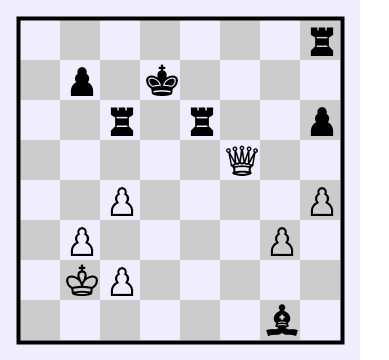
By this time it was midnight and MASTER had used up its quarter ration of half an hour's machine time. We had the mistaken idea that an adjudication was automatic at the completion of 40 moves and requested one from the tournament referee David Levy. Not only were we mistaken about the 40-move limit but Levy said (correctly!) that if we did not continue then he would award the decision to TECH 2.
Convinced that the position was objectively drawn we stoked up the machine and ran on for another 48 moves. Unfortunately MASTER disagreed with us, it believed it was winning the game and disdained a draw by perpetual check (it would have done this if it thought it was losing). The final outcome was that TECH 2 eventually co-ordinated its pieces, broke through and gave mate.
TECH'S most infuriating habit in this game derived from its steady, plodding nature, it always took the same time over every move - even if the move was forced - so the game took until 03.30 to finish. At the finish I had been on a phone for over 7 hours and began to appreciate the stamina, concentration (and hearing) required to take part in World Tournaments.
The next night we got lucky and played another British program. This program, written by Bob Prinz, was relatively new to the game and blew up in the opening moves - it thought it had such a strong position that its evaluation function overflowed and it started to look for the worst moves it could play. There was also the idiotic irony of the two programs playing each other via long, expensive links to and from Stockholm when physically the machines were less than 50 miles apart.
In the third round we were lucky again and played a Swiss program, TELL. This program was also underdeveloped and the game was later analysed by a good player, David Pritchard, in the magazine Games and Puzzles. It is interesting to see just how good MASTER appeared to be at this point in its career - the point at which MASTER had played about 6 hours competitive chess. It is also interesting to read the chess experts' opinions as to why the programs chose their moves.
1 P - K4 P - K4 2 N - KB3 N - QB3 3 B - B4 B - B4 4 P - B3 P - Q3 5 P - Q4 P x P 6 P x P B - N5+ 7 K - B1! P - KR4
One can almost hear the computer reason the king is on the king's side and cannot castle so I must attack.
8 Q - N3! B - N5 9 B x P+ K - Bl 10 B x N R x B 11 Q - Q5
A mistake. P-Q5 here wins a piece - but then computers are only human ....
11 ... B x N 12 P x B R - R1 13 N - B3 B x N 14 P x B P - R4
Has TELL been told about moving rook's pawns?
15 QR- Nl Q - B1 16 B - B4 Q - R6+
17 K - K2 N - Ql (see Fig. 9)
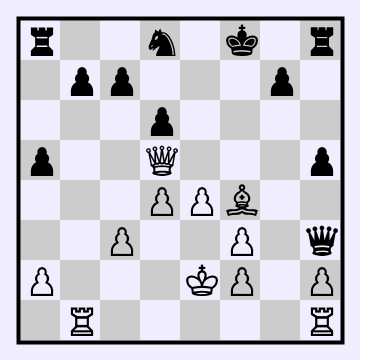
18 B x P+
It would be interesting to know how far ahead MASTER had been calculating at this point. The sacrifice is certainly sound.
18 ... P x B 19 Q x P+ K - B2 20 KR- Nl KR- Nl
White was threatening 21 Q-B7 + to win the KNP.
21 QR-N5
Preparing R-B5+ when White would mate or win Black's queen, so ...
21 ... P - KN3 22 Q - B7+ K - K1 23 R - K5+ N - K3
Black could give up here but COMPUTERS NEVER RESIGN.
24 Q x NP R - Q1 25 R - N3 Q x P 26 R x N+ K - B1 27 Q - K7++
The game illustrates the very real precocity of chess programs both in talent and speed. For example, how many beginners would play moves 7 and 8? MASTER really seems to know what it is doing but then blunders at move 11.
The reason for this is that MASTER was undervaluing knights and also because of the Black counter play
11 P - Q5 Q - K1/2 12 P x N Q x P
and Black has command of the centre plus two squares next to White's king - if the KN is lost then mate is threatened. All this was too vague and dangerous for MASTER's limited look ahead (3 moves on each side) and was rejected. The bishop sacrifice at move 18 gives white control of almost all the top left of the board and was so attractive that it actually only took about 1 second to calculate, a very fast move even for a machine.
On the last night, having won two easy games, MASTER again met a tough opponent, RIBBIT from Canada. At one point in this game Peter Kent, who was in Stockholm, told us that if MASTER won then there was a chance that it could play off for the championship but, unfortunately, TECH 2 had been a costly game in sabbatical time and MASTER was set to play very quickly, missed its chances and gave away a piece. The position at move 54 was (Fig. 10) and Peter Kent asked me if MASTER was saying it wanted to resign. Actually the program had been bleating this message out for the previous 10 moves which just proves that computers can resign but their authors rarely allow them to.
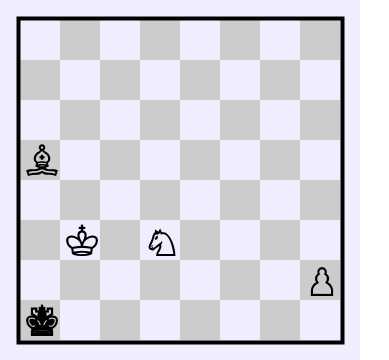
The reason is simple - of course the game is objectively lost but MASTER had played 54 moves in about 17 minutes of machine time and still had plenty of time on its tournament clock. There are two possibilities still open - White might blunder and give stalemate or (if we delayed our forced replies) RIBBIT's machine might crash and we could even win on a time default.
Unfortunately the British do not stoop to such low tactics, and with cries of It's taking part that counts! we rushed to our doom. RIBBIT quickly queened its pawn with a check and mated with Q-N7. I still wonder if it could have done it if the BK had been in QN8 to begin with, the urge to queen a pawn might have overridden a stalemate check but (as we shall see later) RIBBIT has what Napoleon asked of his generals, it's a lucky program.
At the end of the tournament, MASTER had won 2, lost 2 and, on our unofficial tie breaker of how fast a program had won or how slowly it had lost, was placed about fifth out of the thirteen contestants. Total machine time used 1 hour 57 minutes 27.3 seconds.
During the tournament we had not been linked directly to Peter Kent in Stockholm but had been relaying our moves algebraically through London where another chess program was also competing in the tournament. This relay had caused us to use a voice code for the moves (ABLE, BAKER, CHARLIE, DOG, EASY, FOX, GEORGE, HOTEL) and, oddly enough, we never sent or received a bad move.
The troubles with this double link were time problems (not that this mattered after the TECH game but it was never very clear if the total double transmission time was counted on our tournament clock). Also we had almost no idea what had been happening in the other games and no chance to modify the program between games. (In one game we had played 10 moves before finding out what we were playing.)
At the end of the tournament almost all we knew was that CHESS 4,0 had been beaten for the first time in its tournament career and that the winner was KAISSA, the solitary entrant from Russia.
About a week later David Slate and Larry Atkin stopped over in England on their way back to America. They had come second and even played KAISSA to a draw in an exhibition game after the tournament proper. With their recollections (and later, those of Peter Kent when he returned) we were able to piece together what had happened in some of the other games plus some of the atmosphere.
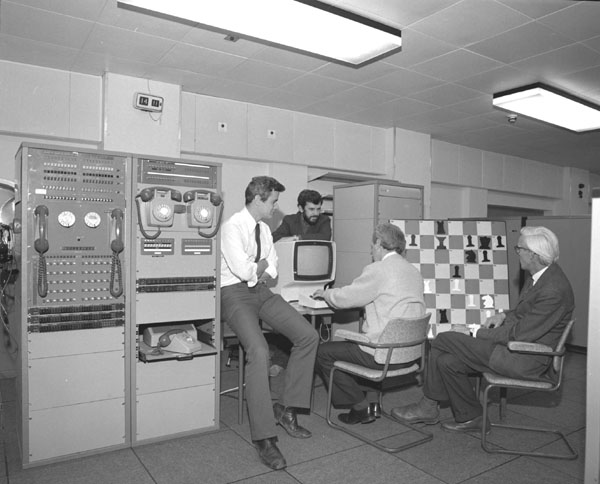
The most striking thing about a computer chess tournament really is the atmosphere. It is a noisy circus with the audience free to loudly comment upon, criticise or applaud the moves of the contestants - a freedom which is fully indulged. Apart from this noise there is the clatter of teletypes, the hum of the machines which are there in person and people shouting moves into telephones.
On top of all this noise and confusion the tournament referee, David Levy, was giving an official commentary on the games as they progressed on big display boards. Levy is an International Master who gives a unique performance on such occasions, he has a tendency to ask the author of a program why it has just played a move - usually a bad move. The author often squirms, mumbles and David Levy then announces loudly over the public address system: THE AUTHOR SAYS HE DOESN'T KNOW WHY HIS PROGRAM PLAYED THAT MOVE. All good stuff but computers, like elephants, never forget and perhaps one of these days (a wishful thought) a program is going to ask Levy the same question.
The real sensation of the tournament was CHESS 4.0's first loss to another program. This happened on the second night when its opponent was CHAOS, another American entry. The following position was reached after 15 moves (Fig. 11).
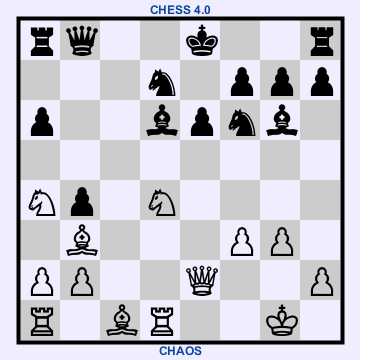
CHAOS played 16 NxP!! - a move which has been acclaimed as the finest ever made by a computer. White evaluates that his domination of open lines is compensation for a piece. This judgement is absolutely correct. Of course the piece is not sacrificed entirely and play continues in a very similar fashion to MASTER's sacrifice of a bishop to TELL.
16 ... P x N 17 Q x P+ B - K2
CHAOS then developed quickly and put on the pressure
18 R - Kl Q - Q1 19 B - KB4 K - B1 20 QR- Q1 R - R2
and, although CHESS 4.0 was defending well, CHAOS had a grip on the game which it never lost.
The ending was an anticlimax. At move 52 the position was (Fig. 12)
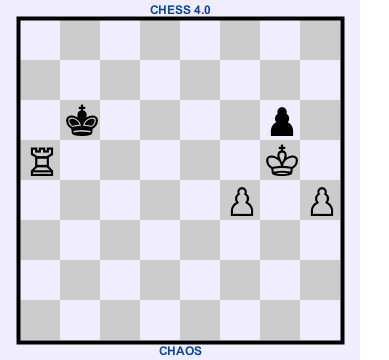
a won game but CHAOS displayed a typical weakness of chess programs by taking another 27 moves to effect the mate (it can be done in only nine moves: R-K5 then WK x P and queen the rook pawn). This slow win was later to cost CHAOS the chance of a playoff for second place.
At the end of the game, David Levy asked one of the CHAOS authors why it had played the knight sacrifice only to receive the usual reply. However, the author was then heard to mumble that he'd make damn sure that it never does it again.
Apart from the game there were other, more mechanical problems. Two incidents that occurred in round 3 were particularly amusing. The first again concerned CHESS 4.0 who was playing OSTRICH, yet another American program, which derives its name from the horizon effect. OSTRICH runs on a dedicated Nova computer which is so small and mobile that it was wheeled into the tournament hall and is driven with a demountable disc pack. At move 31 the Nova teleprinter began to give trouble and Monty Newborn, the author of OSTRICH, decided to remove the disc pack, get on a motor bike and try to find another Nova computer. Slate waited patiently in the tournament hall conjuring up visions of Newborn roaring round Scandinavia trying to catch another Nova computer and perform a mind graft in order to continue the game.
Contestants are allowed 20 minutes in the event of machine failure so OSTRICH was only in slight trouble when Newborn eventually stuck OSTRICH's head into another Nova and was able to continue over a telephone link. Despite all these heroics OSTRICH lost on the 48th move.
Machines that can balance poles on moving carts and, possibly, ride motor bikes have been developed by Professor Donald Michie.
Meanwhile a second incident had taken place between KAISSA, the Russian program named after the goddess of chess, and CHAOS. The Americans had input a Russian rook move incorrectly at move 27 (a common human error when rooks are sharing ranks or files) and the result had been an apparent mate in two for KAISSA. The telephone link to Moscow had rung off before the CHAOS team discovered their error and appealed to David Levy to restart the game. Efforts to contact Moscow were unsuccessful - probably the Russians were too busy celebrating with vodka - so the audience was treated to yet another new spectacle; the sight of two humans trying to play chess like a computer.
The two humans were David Levy and Dr. Mikhail Donskoy, one of KAISSA's authors. The situation was doubly ironic for Levy because he is a master chess player who has bet that no program will beat him before 31 August 1978.
Eventually Levy and Donskoy came up with an 11-move continuation which gave a win for KAISSA. This win would become official unless Moscow could be contacted early the next afternoon and continue the game before the final round.
At 5 o'clock the next day the Russians phoned in to find out which program they were to play in the final round. When told the circumstances they sportingly agreed to restart the game and were delighted to see KAISSA find a 9-move continuation to mate, i.e. 2 moves better than the human simulators. Unfortunately nobody asked Levy why he had chosen his moves.
At the end of the tournament Donskoy was presented with a gold medal donated by the well-known publisher Mr. Robert Maxwell. KAISSA had won and the contestants, particularly the Americans, began to analyse its performance. Probably the best analysis so far is by Dr. Hans Berliner:
The most intriguing question from the whole event is "what is the structure of KAISSA?" We note that in all its games it had at one point or another a very bad position. Frequently, it blundered right after leaving its opening book. Despite these errors, KAISSA managed to Overcome its disadvantages. This appears to be due to the more error-free nature of its subsequent play. Nevertheless, this raises the question as to why it should make errors in what most programmers would consider simple positions.
Berliner chose the most outstanding error as move 8 in the post tournament game against CHESS 4.0.
CHESS 4.0 KAISSA
1 P - K4 P - Q4
2 P x P N - KB3
3 P - Q4 N x P
4 N - KB3 P - KN3
5 B - K2 B - N2
6 0-0 0-0
7 R - K1 B - B4
8 N - R4 ...
So far KAISSA had played from its book but now it had to compute a move and came up with
8 ... P - K4
A move which, in Berliner's opinion, gave a significant advantage to CHESS 4.0; also a move which no self-respecting class 'B' player (1600-1800) would admit having made (if he made it and was shown the analysis, he would claim to have been sick, etc.).
CHESS 4.0 likes to mess up its opponent's pawns so it took full advantage of the error
9 N x B P x N 10 P x P N - N5 11 Q x Q? R x Q 12 B - KN5 R - Q2 13 N - R3 B x P 14 P - QB3 N/5-B3 15 N - B4 P - QR4? 16 B - B3 P - B3 17 B - R6 P - R5 18 QR- Ql R x R 19 R x R K - R1?
At this point Berliner stated that the game was essentially won for CHESS 4.0, i.e. it should win nine times out of ten from the position.
9 N x B P x N 20 B x N N x B 21 P - B4 P - N4 22 P x B P x N 23 P x P R - Q1
If KAISSA's opponent were a class 'B' human then this would be a hopeless end game. Unfortunately for CHESS 4.0 the Russian program noticeably tightened its play from this point and a draw was finally agreed at move 65. A disappointment for Slate and Atkin but even worse was to come.
The fifth United States Championship took place a few months later and was won by RIBBIT; included among RIBBIT's perfect four-point triumph was a victory over CHESS 4.0, their third encounter and third time lucky.
Now the reader should recall that MASTER had lost two games in the World Championship - one to RIBBIT and the other to TECH 2. We were therefore particularly interested to read that the following position had been reached in the third round game between MASTER's victors (Fig. 13).
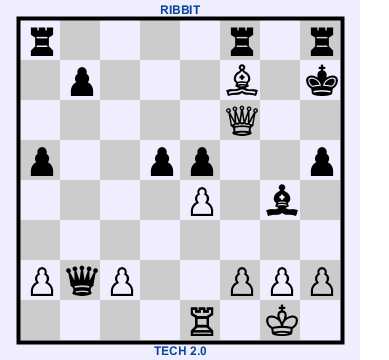
It was TECH to play its 23rd move and, in its usual plodding way, it had just sat there and eventually time faulted - how lucky can you get? (The closest equivalent in human play was probably Reshevsky missing a mate-in-two in a world championship qualifying round.) And so by the end of 1974 it was becoming clear to more and more people that the best chess programs were still capable of the most pathetic blunders. Suggestions, comments and criticisms began to appear from people outside the field of computer chess programs. Many of these people stated that all the World Championship and the fifth ACM tournament had shown was that the brute-force crunchers still didn't know what they were doing - what the programs needed was less searching through massive trees and more of that intangible asset - KNOWLEDGE, the phlogiston of the Artificial Intelligentsia.